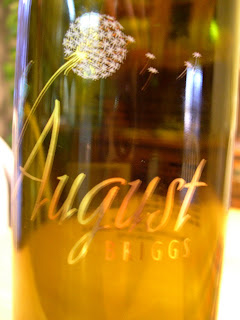
I first became aware of Old Vine Zinfandel when I visited
August Briggs in
Napa. If you haven't visited August Briggs, do your self a favor and head to Napa. After visiting large wineries all day with employees that charge you a fee and then oblige you to listen to their canned speech, stopping at this small winery was a breath of fresh air. I liked several things about the winery. The winery's symbol is a dandelion blowing in the air, which I found to be both unique and courageous, since although the dandelion may be one of the most expensive salad greens in France, it is considered a weed in the States.
There were no canned speeches at August Briggs. Although I tasted several interesting wines there, the Zinfandel really stood out. I had tasted Zinfandel all week long, and not purchased a single bottle, opting instead for Cabernet Sauvignon, Pinot Noir, and Port. This Zinfandel at August Briggs was excellent. It had a spicy punch to it that I had never experienced. I purchased several bottles, and asked for another taste. Seeing how much I liked the Zinfandel, I was offered the chance to do a barrel tasting. How could I say no? I had been in Napa for a week, and had not been made a similar offer.
First we were offered a glass from a barrel which was claimed to be new vines. I did not understand what that meant to the taste, however, upon tasting, the new vine batch was definitely not what I had tasted previously. It was green and one dimensional like the Zinfandels I tasted at other wineries earlier in the week. Second we drank from a barrel which was said to consist of approximately 50-year-old vines. It was spicy, and more reminiscent of what I tasted earlier. Third, we tasted from a barrel which was said to consist of approximately 100-year-old vines. This was amazing, so spicy it burned the mouth. This wine was like nothing I tasted before, and was even better than what I had raved about and purchased. I told our host to bottle some of the third barrel up, and I would buy it.
Our host explained, as the Zinfandel vine ages, it produces fruit that is more complex and spicy. Relatively speaking, there are not a lot of 100-year-old vines around, and their supply is low; instead of selling it, they blend it with the 50-year-old, and the new vine to get the taste I had liked so well. This was one of my top experiences in Napa, with the exception of experiencing a wine tasting with
Elaine Honig. It was certainly the biggest winery-born revelation for me since learning about
Veuve Cliquot's invention of
le remuage.
Armed with my new found knowledge, I set off to determine if my local wine shop had Zinfandel made from Old Vines. There are several Old Vine Zinfandels on the market:
Bogle Vineyards,
Gnarly Head,
Seghesio to name a few. Some are not bad, some do not taste "old", after my experience. That leads me to the question: what does it mean to label a wine "Old Vine Zinfandel?" How old must the vines be? What percentage of the wine must be old as compared to new? I could find nothing that regulates the use of this term, so it is clearly a trust and taste situation.

